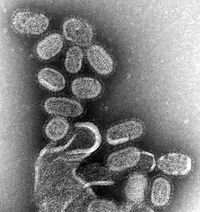
Photo from wikipedia
BACKGROUND The purpose of this study was to evaluate the safety and efficacy of early venous thromboembolism (VTE) chemoprophylaxis following blunt solid organ injury. METHODS A retrospective review of patients… Click to show full abstract
BACKGROUND The purpose of this study was to evaluate the safety and efficacy of early venous thromboembolism (VTE) chemoprophylaxis following blunt solid organ injury. METHODS A retrospective review of patients was performed for patients with blunt solid organ injury between 2009-2019. Enoxaparin was initiated when patients had <1g/dl Hemoglobin decline over a 24 h period. These patients were then categorized by initiation: ≤48 h and >48 h. RESULTS There were 653 patients: 328 (50.2%) <48 h and 325 (49.8%) ≥48 h. Twenty-nine (4.4%) developed VTE. Patients in ≥48 h group suffered more frequent VTE events (6.5% vs 2.4%, p = 0.021). Non-operative failure occurred in 6 patients (1.9%) in ≥48 h group, and 5 patients (1.5%) < 48 h group. Blood transfusion following chemophrophylaxis initiation was required in 69 (21.3%) in ≥48 h group, and 46 (14.0%) in < 48 h group, occurring similarly between groups (p=0.021). CONCLUSION Stable hemoglobin in the first 24 h is an efficacious, objective measure that allows early initiation of VTE chemoprophylaxis in solid organ injury. This practice is associated with earlier initiation of and fewer VTE events.
Journal Title: Injury
Year Published: 2022
Link to full text (if available)
Share on Social Media: Sign Up to like & get
recommendations!